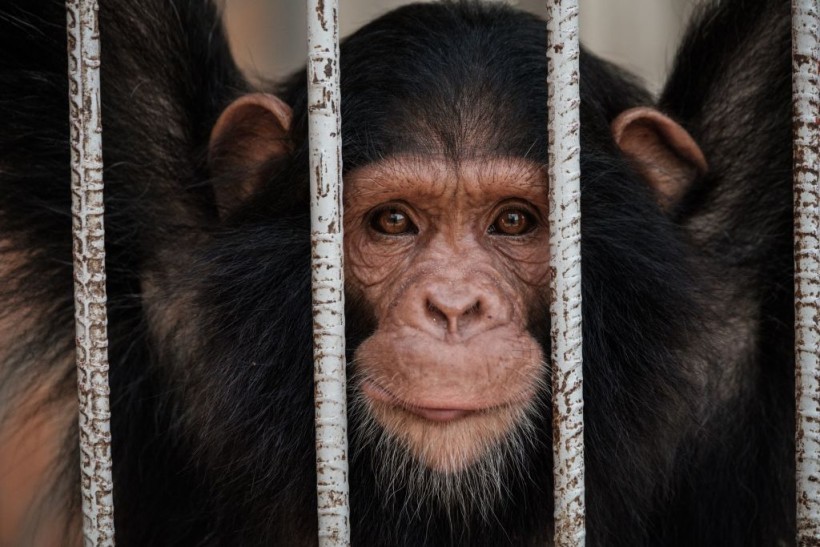Experts from Germany's Max Planck University of Evolutionary Anthropology discovered that chimps have a very complex communication system, with "words" that they can combine into "sentences."

A sheltered juvenile chimpanzee looks from a cage at Musee Vivant de Bujumbura (the Living Museum of Bujumbura), in Bujumbura, Burundi, on March 14, 2022. - Burundi is classified as the poorest nation in the world in terms of GDP per capita, according to the World Bank. But here too, as in other countries, young people, who make up the majority of Burundi's population, are increasingly connected. Launched in 2021, the VisitBurundi initiative brings together around a dozen volunteers who organise trips for large groups of visitors, help to spruce up tourist destinations and, above all, broadcast Burundi's charms to the world. The team is inspired by Dubai, where influencers thronged to beaches and bars even during the pandemic. Bujumbura is not yet Dubai, but the prospects for tourism, domestic and international, are looking up.
Chimpanzees Reveal a Hidden Language
In a new study, researchers looked at almost 5,000 recordings of wild adult chimp calls in Ta National Park in Côte d'Ivoire (aka Ivory Coast).
According to ScienceAlert, when scientists studied the pattern of sounds captured on the transcriptions, they discovered 390 different auditory ways comparable to various phrases generated from diverse sound types.
Around 390 distinct patterns might not seem much compared to the practically unlimited possibility for human phrase creation. However, no one knew until recently that nonhuman chimps had a variety of ways to communicate with one another because nobody had tested their communicative abilities to a degree.
Wildlife scientist Tatiana Bortolato of Germany's Max Planck Institute for Evolutionary Anthropology said in a statement that the findings suggest that ape auditory transmission is significantly more intricate and structured than previously thought,
The researchers wanted to know how chimps organize single-use sounds into patterns, organize those sounds within chains, and reassemble distinct patterns into longer repeats. Although chimp signal combinations have been studied before, how they make up their whole hearing capabilities has never been subjected to a large-scale quantitative study.
The researchers recorded 900 hours of natural adult foreign chimp (Pan troglodytes verus) discussions from three different chimp communities in Ta National Park to address this.
Furthermore, by analyzing the utterances, the scientists determined how auditory stimuli may be uttered single, in two-time series (bigrams), or in three-unit patterns (trigrams).
ALSO READ: Gorilla vs. Chimpanzee: Who Wins in Their Battle and Why Do They Fight?
Experts also looked at how different sorts of typical speech patterns were ordered and blended and sound mixing mapping systems (for example, bigrams within trigrams).
Overall, 12 different sound kinds were detected, including moans, gasps, hoos, growls, shouts, and whines, all of which seemed to indicate additional roles based on how they were used and the conditions in which the discussion took place.
Experts Have Yet To Understand These Creatures
The researchers discovered that these various types of commands could be combined in a variety of ways to create 390 different kinds of interludes, which experts consider to be an outlier in terms of novel auditory patterns discovered as the researchers approached their site playback restriction.
Nonetheless, the data so far reveals that chimp correspondence is substantially more intricate than previously assumed, which has implications for the complexity of points directly in their speech and provides fresh insights into the beginnings of human language.
According to the scientists, the chimp auditory network consists of 12 call types used as solo units, bigrams, trigrams, or more extended series to transmit scores of different meanings.
While this possibility is significantly less than the endless number of different interpretations that verbal communication can provide, it still provides a framework beyond what was previously considered realistic in monkey processes.
Brill also stated that the team would be able to obtain even more extensive collections of chimp calls in the future to investigate how the diversity and sequencing of spoken patterns relate to flexible signal creation, which researchers did not investigate in this study.
Researchers seek to get fresh insights into where we come from and how our specific language evolved by studying the rich intricacy of wild chimp speech patterns, a highly intellectual mammal-like human.
The study was published in the journal Communication Biology.
RELATED ARTICLE: Hybrid Monkey Sighting in Borneo Sparks Discussion About Lab-Made 'Humanzee' Super Soldiers [REPORT]
Check out more news and information on Animals in Science Times.














